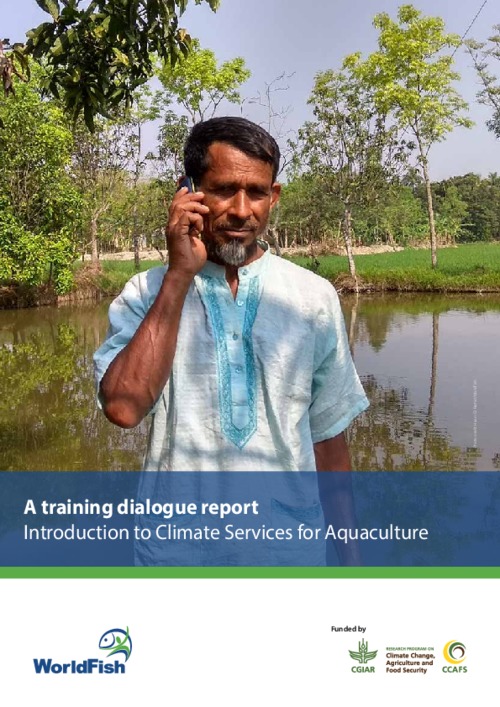A training dialogue report: Introduction to Climate Services for Aquaculture

Citation
WorldFish. (2020). A Training Dialogue Report: Introduction to climate services for aquaculture. Capacitating farmers and fishers to manage climate risks in South Asia (CaFFSA) - CGIAR Research Program on Climate Change, Agriculture and Food Security. Penang, Malaysia: WorldFish. Program Report: 2020-04.
Aquaculture is critically important to food and nutrition security in Bangladesh. It provides 60 percent of animal protein requirements for Bangladeshis and makes up 3.65 percent of the country’s GDP . It has pulled more than 2 million of the 18 million Bangladeshis who came out from poverty. However, the sector is vulnerable and impacted by climate variability. High temperatures can affect fish growth and reproduction and erratic rainfall and fluctuation in temperature impact fish spawning. Shallow pond fish are particularly vulnerable to high temperatures. High temperatures also increase the growth of microphytes, leading to oxygen depletion and habitat degradation. Against this backdrop, climate services hold tremendous potential for aquaculture by providing timely information and tools to support more climate-resilient decisions. So far, however, climate services research and projects addressing food security in Bangladesh have largely focused on land-based agriculture. Information about the specific needs for climate services in the aquaculture sector remains scarce. This report addresses this gap. The training dialogue began with participants identifying different climate-sensitive management decisions they make and the climate information needed to inform those decisions. Climate plays a critical role in activities and decisions regarding releasing fingerlings, the timing of fish spawning, fish culture periods, pond aeration and pumping water. Water temperature, for example, can impact decisions on a variety of important factors, including irrigation, feeding, applying lime, managing water depth, netting, stocking fish feed, breeding and fertilizing. Rainfall can impact decisions on the use of input materials like paddle wheels, aqua medicine, aerator, zeolite, protective nets in ponds etc. and also feed management. Participants were then introduced to the basics of climate and climate services as necessary to directly address decisions and needs for aquaculture. Key concepts covered climate, weather, climate variability, timescales in weather and climate information, the source of climate data (buoys, weather stations, satellites), types of climate data (observational data, satellite data, model data), and lead time, uncertainty and sources of predictability of forecasts. The four pillars of climate services—production, translation, communication, use—were also described. A series of hand-on exercises was followed. This allowed participants, trainers and facilitators to jointly unpack information needs and identify climate service opportunities and challenges. They did so according to timescale, specific aquaculture activities and through mapping the flow of information among stakeholders and along the four pillars of climate services. Through stakeholder mapping, suggestions for including new entities arose, such as the Ministry of Fisheries and Livestock (MOFL), shrimp farmers associations and trawler associations. Examples were then given of climate services already developed for agriculture. Examples included participatory communication processes, such as the Participatory Integrated Climate Services for Agriculture (PICSA) approach developed by the University of Reading with CCAFS. Other examples included tools developed under CSRD by CIMMYT, or the Intelligent Agricultural Systems Advisory Tool (ISAT), which is an advisory tool by ICRISAT. Some relatively new aquaculture applications were also presented, including BMD aquaculture app as well as the Rupali app by the ACI, which is supported by WorldFish. After discussing the strengths, weakness and applicability to aquaculture of these climate services, the training dialogue familiarized participants with readily available climate products at BMD. These included the Maprooms and Enhancing National Climate Services (ENACTS) data products, recently developed under ACToday, which are based on a gridded dataset merging both BMD observation data and satellite data along with re-analysis data. Through hands-on exercises, the participants explored how to access rainfall and temperature information online using the freely available interactive Maproom interface. They were also given the opportunity to discuss different aspects of these tools and suggest improvements. Over the various activities of the week, participants identified threats and opportunities and provided recommendations for different stakeholders to enhance the development of climate services for aquaculture. Suggested recommendations included strengthening collaboration among different government organizations, such as BMD, Department of Fisheries (DOF), Bangladesh Fisheries Research Institute (BFRI) and the Department of Agriculture Extension (DAE). They also emphasized the need for follow-up training, as well as capacity building of different stakeholders, such as aquaculture personnel, extension officers and researchers. It is important to highlight that women were not represented at the event, except for one participant and some of the facilitators. Although unintentional, participants selected from value chain actor organizations were male. This opened the door for possible gender biases. These include assessing climate-sensitive decision-making processes and information needs relevant to only male value chain actors, and considering the strengths and weaknesses of existing climate services solely from the perspective of male stakeholders. To avoid gender biases outcomes in future training events, more deliberate efforts are necessary to represent the diversity of actors’ perspectives in selecting participants.
Permalink
Date Available
Type
Publisher
Countries
Copyright
CC-BY-4.0
Research Themes
Topics
Language